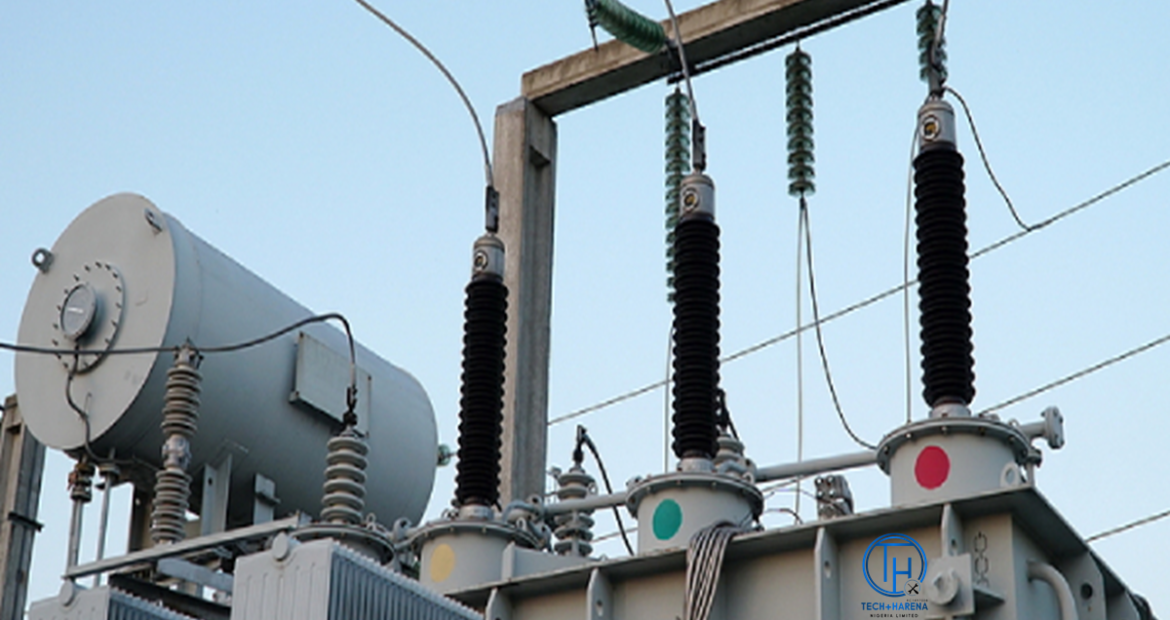Power transformers are essential for efficient electrical power distribution, playing a crucial role in increasing the current and voltage needed for various appliances in homes and businesses. Without a quality power transformer, your property would lack reliable electricity during crucial times. At Tech+Harena Nigeria Limited, we ensure the highest standards of engineering design, construction, and installation services. This comprehensive guide will walk you through the detailed steps and considerations for installing a transformer, ensuring safety, efficiency, and reliability.
How To Install A Main Transformer?
Installing a power transformer is a complex procedure requiring expertise, care, and precision. Here are the steps to ensure a safe and efficient installation:
Step 1: Area Considerations
Ensure the installation site is well-ventilated, free from corrosive or flammable materials. Verify the transformer’s nameplate specifications (kVA, frequency, line voltage, and load voltage) match the application’s requirements. This step is crucial for ensuring the transformer operates safely and efficiently.
Step 2: Mount the Transformer
Carefully position the transformer at the installation site. Follow lockout/tagout procedures to disable the mains power supply. Remove the panel covering the wires to access the connection points.
Step 3: Adjust The Correct Tap Setting
Isolate each secondary tap and adjust the primary taps as needed. Before handling taps, remove any protective coatings and clean the taps thoroughly. Apply an electrical compound before bolting the wire to ensure a secure and efficient connection.
Step 4: Route Wires Through Holes
Use existing holes or drill new ones to feed cables into the enclosure. For ventilated devices, ensure cables enter below the terminals and coil to prevent obstruction and ensure proper ventilation.
Step 5: Ground the Transformer
Proper grounding is vital for safety and compliance with the National Electrical Code and other standards. Ensure the enclosure is adequately grounded to prevent electrical hazards.
Step 6: Energize The Transformer
Check the secondary voltage to ensure it meets the load requirements. Verify that the main power supply is shut off using lockout/tagout procedures before energizing the transformer.
Step 7: Connect to Terminals
Connect the load to the secondary terminals and replace the power supply cover. Ensure all connections are secure and properly insulated.
Step 8: Perform A Final Inspection
Before powering the transformer, perform a thorough inspection to ensure all components are correctly installed and secure. Inform all personnel involved in the installation process before energizing the transformer, as all connection points inside the enclosure carry fatal voltages.
What Are The Safety Operation Procedures During Transformer Installation?
Safety is paramount during transformer installation. Adhere to the following procedures to ensure a safe and effective installation:
Storage
Store transformers in their original packaging in a temperature and humidity-controlled environment. Avoid storing transformers outdoors without adequate protection.
Safety Operations
Securely fasten removable covers and never use devices with unsecured parts. Regularly review and audit safety protocols to maintain high safety standards.
Grounding
Ensure all grounding is performed safely and correctly according to the National Electrical Code and local regulations.
System Loading
Adjust the transformer’s kVA rating if the average outside temperature exceeds 30 degrees Celsius or the altitude exceeds 3,300 feet.
Maintenance
Regular inspection and maintenance are crucial, especially in harsh environments, to ensure the transformer operates efficiently and safely.
How To Establish A Pad-Mounted Transformer Installation?
Pad-mounted transformers are crucial for electric power distribution in many settings. Follow these steps to ensure a successful installation:
Step 1: Secure a Strong Foundation
Ensure the concrete pad is flat and stable, with deep enough footings to prevent settlement and heave. Secure the transformer’s base to the pad using the provided mounting brackets.
Step 2: Inspect the Seal
Check the fluid-level indicator and remove the pipe plug from the low-voltage area cautiously. Ensure proper sealing after each use to maintain integrity.
Step 3: Ensure External Electrical Connections
Properly connect the system ground to the tank ground and ensure compliance with voltage ratings. Disconnect all cables and plugs when not in use.
Step 4: Close The Cabinet
Lock the cabinet securely using the padlock and other means provided to prevent unauthorized access.
What Are The Properties Of The Transformer Diagram Upon Installation?
Understanding the components and properties of a transformer is essential for successful installation:
Operating Theory
An alternating current (AC) flows through the primary winding, causing magnetic flux in the iron core to fluctuate and induce voltage in the secondary winding.
Core
The core is the heaviest and most important part, made of steel to ensure low magnetic resistance and high permeability.
Windings
Windings consist of insulated copper or aluminum coils with multiple layers of paper insulation between the turns.
Tap Changer
The tap changer adjusts the transformer’s output voltage, ensuring it meets the load requirements.
Bushings
Bushings connect the grounded tank to the network and windings, ensuring safe and efficient operation.
What Are The Necessary Transformer Installation Requirements?
Adhering to specific requirements is crucial for a successful transformer installation:
Requirement No 1: Installed by Electrician
Ensure a qualified electrician installs the transformer.
Requirement No 2: Choose The Right Nominal Power
Verify the total power output to match input voltage variations.
Requirement No 3: Verify That The Power Factor For The Load Is Valid
Confirm the load’s power factor to ensure accurate transformer operation.
Requirement No 4: Validate The Input-Output Voltage
Double-check the input-output voltage during full load operation.
What Is The Method Statement For Transformer Installation?
The method statement outlines procedures to prevent environmental hazards during installation:
- Store transformers in a dry, secure location.
- Inspect transformers for shipping damage.
- Adhere to project specifications for cable, wire, and fitting installations.
- Tighten all electrical connections to manufacturer-recommended torque values.
What is Commissioning? Is it Necessary for Transformer Installation?
Commissioning tests the functionality of the power transformer before use:
- Perform pre-commissioning checks and instrument tests.
- Conduct tests for protection system effectiveness, insulation resistance, capacitance, and dissipation factors.
Commissioning ensures the transformer is in proper working order before operation.
Conclusion
Installing a transformer is a detailed and complex process that requires careful planning, expert installation, and regular maintenance to ensure safety and efficiency. At Tech+Harena Nigeria Limited, we are committed to providing top-notch electrical engineering services, ensuring your power distribution systems operate seamlessly and reliably. Whether you’re installing a single-phase or three-phase transformer, trust us to deliver excellence every step of the way.
For professional and reliable transformer installation services, contact Tech+Harena Nigeria Limited – the best licensed electrical contractor in Nigeria. Let’s power your dreams and light up your world!





